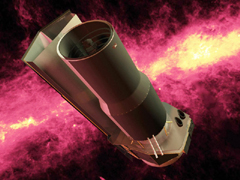Spitzer Space Telescope
|
|

| |
| Organization | NASA, JPL/Caltech |
|---|---|
| Wavelength regime | infrared |
| Orbit | 8.7Ě106 km (5.4Ě106 mi) (heliocentric, trailing Earth at L5) |
| Launch date | August 25 2003 |
| Deorbit date | circa 2008 |
| Mass | 950 kg (2090 lb) |
| Other names | Space Infrared Telescope Facility, SIRTF |
| Webpage | spitzer.caltech.edu (http://www.spitzer.caltech.edu) |
| Physical Characteristics | |
| Telescope Style | Lightweight beryllium, cooled below 5.5 K |
| Diameter | 85 cm |
| Collecting Area | 2.3 m2 |
| Focal Length | f/12 |
| Missing image Launch0825-02small.jpg The Spitzer Space Telescope Facility launches from Cape Canaveral Air Force Station in Florida on Monday, Aug. 25, 2003, at 1:35 a.m. EDT (Sunday, August 24, at 10:35 p.m. PDT). |
The Spitzer Space Telescope (SST) (formerly the Space Infrared Telescope Facility (SIRTF)) is an infrared space observatory, the fourth and final of NASA's Great Observatories.
The duration of the mission will be a minimum of 2.5 years, with 5 or more optimal. In keeping with NASA tradition, the telescope was renamed after successful demonstration of operation, on December 18, 2003. Unlike most telescopes which are named after famous deceased astronomers by a board of scientists, the name for SIRTF was obtained from a contest open only to children (to the delight of science educators).
The name chosen was after Dr. Lyman Spitzer, Jr., one of the 20th century's most influential scientists. In the mid-1940s, he first proposed placing telescopes in space.
The US$670 million[1] (http://www.spaceflightnow.com/news/n0312/17sstresults/) SST was launched on Monday 25 August 2003 at 1:35:39 (EDT) from Cape Canaveral Air Force Station on a Delta 7920H ELV rocket. It will follow a rather unusual orbit, heliocentric instead of geocentric, following earth in its orbit, and drifting away from the earth at approximately 0.1 astronomical unit per year. The primary mirror is 85 cm in diameter, f/12 and made of beryllium and cooled to 5.5 K. The satellite contains three instruments that will allow it to perform imaging and photometry from 3 to 180 micrometres, spectroscopy from 5 to 40 micrometres, and spectrophotometry from 5 to 100 micrometres.
| Contents |
Instruments
- IRAC (Infrared Array Camera), a infrared camera which operates simultaneously on four wavelengths (3.6 Ám, 4.5 Ám, 5.8 Ám and 8 Ám). The resolution is 256 x 256 pixels.
- IRS (Infrared Spectrograph), a infrared spectrometer with four sub-modules which operates at the wavelengths 5.3 Ám-14 Ám (low resolution), 10 Ám-19.5 Ám (high resolution), 14 Ám-40 Ám (low resolution), and 19 Ám-37 Ám (high resolution).
- MIPS (Multiband Imaging Photometer for Spitzer), three detector arrays in the far infrared (128 x 128 pixels at 24 Ám, 32 x 32 pixels at 70 Ám, 2 x 20 pixels at 160 Ám)
Earlier infrared observations had been made by both space-based and ground-based observatories. Ground-based observatories have the drawback that at infrared wavelengths or frequencies, both the Earth's atmosphere and the telescope itself will radiate (glow) strongly. This necessitates lengthy calibrations of all images and will decrease the ability to detect faint objects. Previous space-based satellites (such as IRAS, the Infrared Astronomical Satellite) were operational during the 1980s and great advances in astronomical technology have been made since then.
Results
The first images taken by SST were designed to show off the abilities of the telescope and showed a glowing stellar nursery; a swirling, dusty galaxy; a disc of planet-forming debris; and organic material in the distant universe. Since then, monthy press releases have shown off Spitzer's capabilities, as the Hubble Heritage images do for the HST. As one of its most noteworthy observations, in 2005, SST became the first to directly capture the light from extrasolar planets; the "hot Jupiter" planets HD 209458b and TrES-1 respectively. [2] (http://www.spitzer.caltech.edu/Media/releases/ssc2005-09/release.shtml) This was the first time extrasolar planets had actually been visually seen, and earlier observations had been indirectly made by drawing conclusions from behaviors of the star the planets were orbiting.
While some time on the telescope is reserved for participating institutions and crucial projects, astronomers around the world also have the opportunity to submit proposals for observing time. Important targets include forming stars (young stellar objects, or YSOs), planets, and other galaxies. Images are freely available for educational and journalistic purposes.
Spitzer spotted a faintly glowing body in that may be the youngest star ever seen. The telescope was trained on a core of gas of dust known as L1014 which had perviously appeared completely dark to ground based observatories and to the ISO (Infrared Space Observatory), predecessor to Spitzer. The advanced technology of Spitzer revealed a bright red hot spot in the middle of L1014.
Scientists from the University of Texas who discovered the object believe the hot spot to be an example of early star development with the young star collecting gas and dust from the cloud around it. Early speculation about the hot spot was that it might have been the faint light of another core that lies 10 times further from Earth but along the same line of sight as L1014. Follow-up observation from ground-based near infrared observatories detected a faint fan-shaped glow in the same location as the object found by Spitzer. That glow is too feeble to have come from the more distant core leading to the conclusion that the object is located within L1014. (Young, et al., 2004)
| Missing image Spitzer_Valentine.jpg Valentine's Day release: These bright young stars are found in a rosebud-shaped (and rose-colored) nebulosity known as NGC 7129. The star cluster and its associated nebula are located at a distance of 3300 light-years in the constellation Cepheus. |
See also
References
External link
- SST official site (http://www.spitzer.caltech.edu/)
- SIRTF/SST official site mirror (http://sirtf.caltech.edu/)de:Spitzer-Weltraumteleskop
es:Telescopio Espacial Spitzer fr:TÚlescope spatial Spitzer it:Telescopio Spaziale Spitzer nl:Spitzer Space Telescope pl:Kosmiczny Teleskop Spitzera

